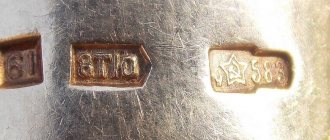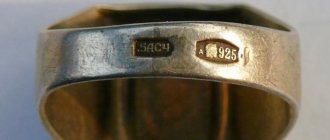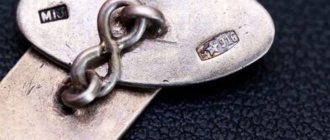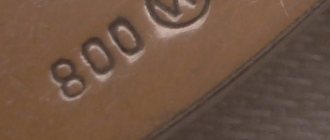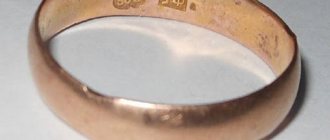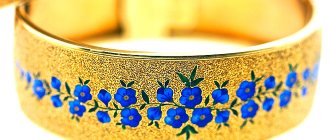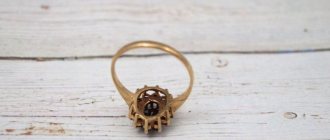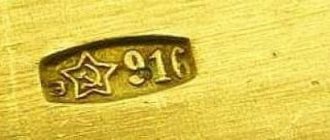Hallmark 333 on a ring - what does it mean and what kind of metal is it, an echo of the Soviet jewelry industry
333 gold purity is equal to 8 carats, the composition of the purest gold for work with such markings is only 33%. Currently, this precious metal is not used in the jewelry industry of the Russian Federation. 333 metal replaced 375 standard immediately after the collapse of the USSR.
New products with this mark are produced only abroad.
Hallmark 333 on a gold ring
What kind of sample is this
Alloys of 333 standard are called low-cork because of the lowest content of pure precious metal compared to other samples - only 33%. Accordingly, they are cheaper than other gold alloys.
Expert opinion
Vsevolod Kozlovsky
6 years in jewelry making. Knows everything about samples and can identify a fake in 12 seconds
In Russia, 333 gold products ceased to be produced after the collapse of the Soviet Union. In their place were products made from 375-karat alloys, the minimum permissible proportion of noble metal in which, according to the requirements of the state standard, is 37.5%.
Jewelry marked “333” can still be found today, but they were produced before the collapse of the USSR or abroad.
Carats in 333 standard
The karate system is most widespread in the USA and European countries. Its name comes from the word “carat”, which is the name of a plant previously used in the jewelry industry of Eastern countries.
Gold samples in carats table
The system is designed to assess the authenticity of the precious metal. The carat is not a metric unit of measurement. This system is indicated by the letter designation “K”.
To determine the number of carats in a marking written as a three-digit number, you can use the table:
| Metric system | 999 | 958 | 750 | 585 | 583 | 500 | 375 | 333 |
| Carat system | 24K | 23K | 18K | 14K | 14K | 12K | 9K | 8K |
| Percentage of pure gold | 99,9% | 95,8% | 75% | 58,5% | 58,3% | 50% | 37,5% | 33,3% |
Existing gold samples in the world
Gold hallmarks are special marks imposed by regulatory government agencies around the world to guarantee the presence of gold in jewelry or other types of products.
In strict accordance with the current legislative framework, regulatory government agencies strictly monitor not only jewelry stores, but also all other institutions that are to some extent related to the sale of precious metal. Therefore, before asking a pawnshop for the price of one gram of gold, you should make sure whether the institution has all the necessary licenses and certificates.
Today, there are four existing sample systems, but the most popular are: metric, carat, spool and lot samples.
Soviet gold markings
The location of the mark will depend on the type of product. On rings, the markings can be found inside the bezel, while bracelets are marked on the last link.
Throughout Russia, the state inspection inspectorate handles the marking of jewelry products. The marking looks like an outline of two rectangles, inside of which there is an imprint of a woman’s face in a kokoshnik, a sample and a special code.
Soviet gold was branded differently. Instead of a woman's profile, the product can be seen imprinted with a five-pointed star, an integral symbol of that era.
Thus, jewelry made from 333 alloy from the times of the USSR must have a hallmark containing three hallmark numbers, a star sign and a letter indicating the year of manufacture.
Ring and earrings made of old Soviet gold
Gold samples according to the metric system
In Russia it is now customary to use the metric system of samples. This system is characterized by ease of use. In other words, the metric system shows how many grams of noble metal are in one kilogram of the total alloy. For example, if one kilogram of alloy contains 415 grams of ligature and 585 grams of pure precious metal, then according to the metric system, this jewelry will have a 585 standard.
Russian jewelers in the vast majority of cases use the following samples:
- 958;
- 900;
- 916;
- 585;
- 750;
- 500;
- 375.
Previously, the 583 standard of the precious metal was widely distributed, which, according to the metric system, corresponded to 14K. Then a proposal was adopted to slightly change the gold standard (due to the difference in the price of gold) from 583 to 585 samples, so that Russian gold jewelry would not be at all inferior in value (per gram) to Western samples.
Rate of 1 gram of gold of 999 purity and calculation of the cost of purity 333
Prices for gold are set by the Central Bank of the Russian Federation, based on the fixing of prices on the London Stock Exchange. The price of a specific sample will depend on the cost of 1 gram of 999 precious metal, which is the highest.
The formula for calculation will be as follows: the metric value of the sample is divided by 1000, and then multiplied by the current price of 1 gram of 999 metal.
For 2021, the price of the highest alloy is about 3,740 rubles. Then the price of 333 alloys is 333/1000 * 3740 = 1245 rubles.
Gold bars
Lot system of gold samples
A similar system existed in Germany until 1888 (before the use of the metric system). This type of gold hallmark is based on marks circulating in the Middle Ages among the Celtic, Scandinavian and Germanic populations of Britain. One stamp contained sixteen lots.
To convert a lot sample into a multiple, the lot system values must be divided by two and then multiplied by three. In case of conversion to the metric system, the value of the lot sample must be divided by sixteen, and then multiplied by 1000.
How to determine the authenticity of 333 samples
First of all, it is always worth inspecting the markings. The presence of all the necessary signs minimizes the risk of buying a fake.
The product can be taken to a pawnshop or jewelry workshop, where it will be checked for authenticity using reagents or special devices.
By the way, professional jewelers can determine the sample itself if the composition of the alloy is in doubt.
Determining the authenticity of 333 samples in a pawnshop
Which sample should I buy?
Everyone in their life has visited a jewelry store at least once and bought gold jewelry. If it was not a purchase for yourself, then it was a gift to loved ones, relatives and friends. In order not to panic and get confused in jewelry stores, you need to imagine in advance: the cost of the desired product, its sample, shade and appearance.
Having clear ideas in this regard, the seller will not be able to be taken by surprise with the question “ten carat gold, what is the hallmark?”, if the store uses not the metric, but the carat standard system. You can always remember that ten carats equals 375 fineness.
You should never chase after more expensive gold jewelry, or dream of owning the noble metal with the highest purity (999). It is not for nothing that for more than a decade, people have given their preference to 585 standard, which has proven itself in matters of strength and long-term use. Products with 999 fineness, although they have the highest level of gold content, are characterized by a high degree of deformation and can become soft. Such products are short-lived and are not suitable for constant use.
Recommendations for the care and storage of antique USSR and low-grade German gold
Low-grade precious metal can leave dark spots on the skin due to its high impurity content. However, contrary to popular belief, such an alloy does not darken. Lack of regular care can cause jewelry to fade, but tarnishing is a myth.
Gold jewelry.
Jewelry works of the USSR Recommendations for care and storage for 333 samples will be as follows:
- Clean your jewelry periodically with washing powder dissolved in warm water. You can clean the products with soft brushes, and then wipe them with a thick-lint towel.
- Protect jewelry from contact with aggressive chemical elements, iodine, and cleaning agents.
- Store low-grade “German” gold in a dark place out of direct sunlight. Also, do not place the product near hot batteries.
These tips will help preserve the 333 precious metal's attractiveness and physical properties.
Composition and properties
The composition of alloy “333” includes at least 33.3% pure metal and 76.3% alloy (impurities from various non-ferrous metals). The following are used as ligatures:
- copper,
- brass,
- nickel,
- silver,
- platinum,
- zinc,
- bronze,
- tin.
333 is common in Europe, where the standard metal color is yellow. Therefore, brass is used as an admixture for color correction.
Depending on the types of ligature present in the gold alloy, its melting point ranges from 900 to 1200 °C.
The alloy does not corrode and has high hardness.
Reviews
I noticed sample 333 on the ring that I inherited from my grandfather. I had never encountered such an alloy, so I began to find out on the Internet what these numbers meant. It turned out that the metal itself is not of particular value; the ring is interesting only from a historical perspective. I kept it for myself as a good memory.
Vasily P, Voronezh
Nastya Z. g, Moscow
The first time I saw 333 gold was when I visited a jewelry boutique in Hamburg. I was fascinated by a thin bracelet made of this alloy, incredibly skillfully made. Outwardly, it was no different from more expensive alloys. I, as an ordinary buyer, would never have thought that the gold content of such beauty was low. I bought this bracelet for my daughter.
I wanted to sell the old bracelet to buyers, but 333 gold has a minimum price per gram in Russia. When they told me the final cost, I decided to keep the jewelry for myself. It may be that in ten years it will become more valuable as an antique.
Evgeniy P. g, Ivanovo
Spool sampling system
Until 1927 in Russia, and after that in the USSR, a spool system was used to designate the sample of precious metal. The key difference between such a standard and the karat system was the designation of pure precious metal through the number 96. All other gold products containing an admixture of other metals were designated by other, lower numbers.
| Try | Spool system | British gold carats | Pure gold content (%) |
| 333 | 32 | 8K | 33.33 |
| 375 | 36 | 9K | 37.50 |
| 417 | 40 | 10K | 41.67 |
| 500 | 48 | 12K | 50.00 |
| 585 | 56 | 14K | 58.33 |
| 625 | 60 | 15K | 62.50 |
| 750 | 72 | 18K | 75.00 |
| 792 | 76 | 19K | 79.17 |
| 800 | 76.8 | 19.2K | 80.00 |
| 833 | 81 | 20K | 83.33 |
| 875 | 84 | 21K | 87.50 |
| 917 | 88 | 22K | 91.67 |
| 958 | 92 | 23K | 95.80 |
| 990 (and above) | 96 | 24K | 99(and higher) |
